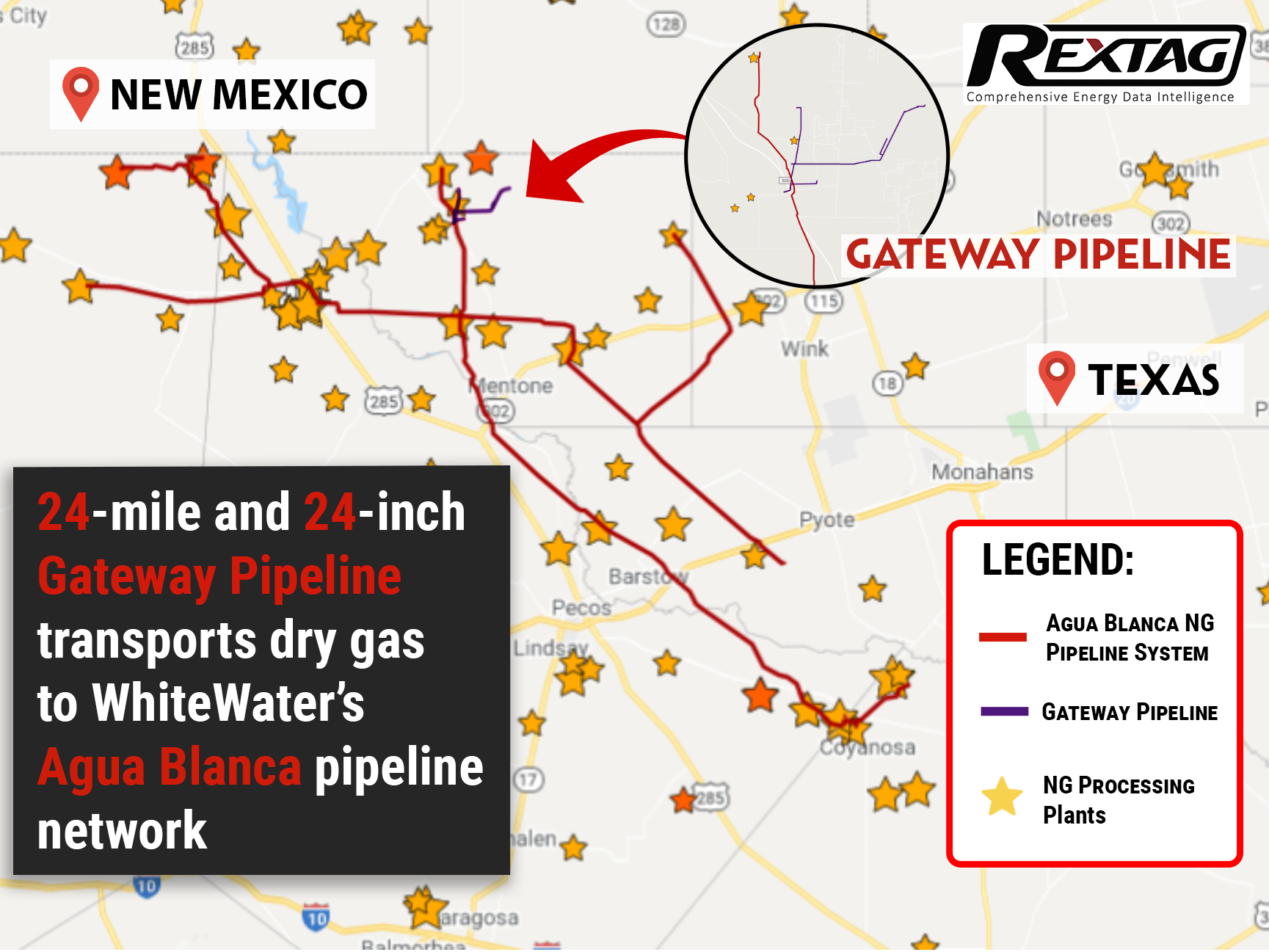Comprehensive Energy Data Intelligence
Information About Energy Companies, Their Assets, Market Deals, Industry Documents and More...
Whitewater Midstream LLC Acquires Gateway Pipeline, Formerly Owned by Sendero
08/28/2021
Whitewater Midstream LLC, a company that manages assets of over 3 billion USD in natural gas transportation in the Permian Basin, has expanded the range of its pipelines after acquiring Sendero Midstream Partner LP’s Gateway Pipeline. It is approximately 24-mile long and 24 inches in diameter. The company has made the acquisition official through an announcement on 26th August 2021. The Gateway pipeline, which was previously owned by Sendero, transports dry gas to WhiteWater’s Agua Blanca intrastate pipeline network.
The amount in which the roughly 24-mile-long pipeline has been acquired by Whitewater Midstream LLC is not disclosed According to Sendero, their formerly-owned Gateway dry gas pipeline has been operational since the second quarter of 2020.
Back in January 2021, Whitewater Midstream LLC announced the expansion of their natural gas pipeline into the Permian Basin that transports gas to the Waha Hub for processing and production. The Agua Blanca system’s capacity is now over 3 Bcf/d. This was a joint venture between Whitewater Midstream LLC and MPLX. This system consists of gas transportation systems with large diameter pipelines.
Additionally, the gas pipeline network facilitates Culberson, Loving, Pecos, Reeves, Ward, and Winkler counties in Western Texas. Agua Blanca connects to nearly 20 gas production and processing stations around the Permian’s Delaware sub-basin. Whitewater Midstream LLC was led by First Infrastructure Capital for its investment in the Agua Blanca project.
Post the company’s Agua Blanca expansion, from April to May 2021, Whitewater Midstream LLC held an open season where they were looking to determining interest in the capacity of 2 Bcf at the Waha Gas Storage facility located in Pecos County, Texas. Its Whistler Pipeline Service began its full commercial operations on 1st July 2021. The Whistler Pipeline service was made to transport natural gas to the markets located in various regions of the Gulf of Mexico. According to the company, this project will ensure the takeaway of an adequate amount of reliable gas. Other than that, the project also envisions to work in the Permian Basin to reduce natural gas flaring.
About Whitewater Midstream LLC
Whitewater Midstream LLC is a management-based infrastructure company based in Austin, Texas. It was founded in 2016 and since then, Whitewater has done business with multiple direct investors and private equity funds. Since Whitewater Midstream LLC has started operating in Texas, it has invested more than 3 billion USD in development projects such as gas pipeline installation, gas production, and other greenfield projects. They were represented by Sidney Austin LLP in the acquisition of Gateway Pipeline, formerly owned by Sendero.
If you are looking for more information about energy companies, their assets, and energy deals, please, contact our sales office mapping@hartenergy.com, Tel. 619-349-4970 or SCHEDULE A DEMO to learn how Rextag can help you leverage energy data for your business.
Black Bear Roars with Success: Mississippi Gas Gathering Assets Sold
![$data['article']['post_image_alt']](https://images2.rextag.com/public/blog/159Blog_Black Bear Roars with Success Mississippi Gas Gathering Assets Sold.png)
Skye MS LLC purchased a package deal from Black Bear, which included over 120 miles of natural gas pipelines and eight active metered locations. Black Bear Transmission LLC, based in Houston, successfully finalized the sale of gas gathering assets owned by BBT Mississippi LLC (BBT MS) to Skye MS LLC of Columbia, Mississippi. The specific amount of the transaction remains undisclosed. BBT MS is the proud owner and operator of a fee-based, natural gas transmission system that efficiently supplies gas to utility, industrial, and power generation customers. It facilitates the connection of wellhead production in Mississippi to regional long-haul pipelines.
Talos Energy Confirms $1.29 Billion Takeover of QuarterNorth Energy
![$data['article']['post_image_alt']](https://images2.rextag.com/public/blog/224Blog_Talos Energy acquires QuarterNorth Energy for $1.29 billion.png)
Houston-based Talos Energy Inc. has made a deal to buy QuarterNorth Energy Inc. for $1.29 billion. QuarterNorth is a company that explores and produces oil in the Gulf of Mexico and owns parts of several big offshore fields. This purchase will add more high-quality deepwater assets to Talos's business, which are expected to bring steady production and new opportunities for growth. The deal should immediately benefit Talos's shareholders and help the company reduce its debt faster.
![$data['article']['post_image_alt']](https://images2.rextag.com/public/blog/328_Blog_Why Are Oil Giants Backing Away from Green Energy Exxon Mobil, BP, Shell and more .jpg)
As world leaders gather at the COP29 climate summit, a surprising trend is emerging: some of the biggest oil companies are scaling back their renewable energy efforts. Why? The answer is simple—profits. Fossil fuels deliver higher returns than renewables, reshaping priorities across the energy industry.
![$data['article']['post_image_alt']](https://images2.rextag.com/public/blog/327_Blog_Oil Market Outlook A Year of Growth but Slower Than Before.jpg)
The global oil market is full of potential but also fraught with challenges. Demand and production are climbing to impressive levels, yet prices remain surprisingly low. What’s driving these mixed signals, and what role does the U.S. play?
![$data['article']['post_image_alt']](https://images2.rextag.com/public/blog/326_Blog_USA Estimated Annual Rail CO2 Emissions 2035.jpg)
Shell overturned a landmark court order demanding it cut emissions by nearly half. Is this a victory for Big Oil or just a delay in the climate accountability movement?